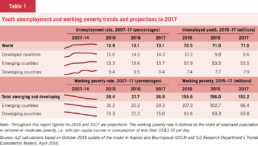‘Youth Building Peace’ is the theme for this year’s International Youth Day on August 12. But while young people are key in amending and mitigating conflicts, larger problems challenge their ability to do so. One of these problems is youth unemployment.
Global youth has long suffered from a climbing curve of joblessness. Numbers from the International Labor Organization’s World Employment and Social Outlook (2016) reveals that 71 million young people are out of a job – half a million more than that in the previous year. Moreover, the number of youth living in working poverty is growing. Sub-Saharan Africa is home to 80 percent more poor working youth than 25 years ago, amounting to 64.4 million people (a staggering 70 percent of youth) living on $3.10 or less per day. In Southern Asia, the percentage is 49, in the Arab states 39.
These numbers are inescapably connected to the migration conflict, which has challenged the capacity and moral accountability of particularly European nations in recent years. More than 35% of African youth expresses a willingness to permanently move to another country compared to the global average of 20 percent. The lack of economic opportunity in their home countries force these young men and women to seek it elsewhere and involuntarily spark political and cultural clashes.

From ILO’s 2016 World Employment and Social Outlook
It is not a bold statement to suggest that the capacity for youth to build peace is crippled by their inability to find decent jobs and pursue educational goals (a point you read more about on the Global Opportunity Explorer): no decent jobs, no lasting peace and nor prospects to “prevent violence and combat terrorism and crime” (target 16.A of the UN’s Sustainable Development Goals).
While there is no quick fix to the global youth unemployment situation, there are a number of business opportunities which combine technology and an interconnected world to create employment on a whole other level than we have seen before. Last year’s Global Opportunity Report identified three of these opportunities to save a “generation wasted”. Focusing on education, connectivity and opportunity for youth, businesses can tap into lucrative markets while getting youth to work.
The digital labor market
The internet has changed everything, including labor. With workplace proximity no longer an issue, a software developer from Kenya can easily work for a Silicon Valley employer thousands of miles away. This is what the digital labor market opportunity is all about. Online platforms can connect youth to job opportunities across geographical and sectoral boundaries and improve the process of job matchmaking. 83 percent of Canadian and US employers says there is a shortage of local software developers. Extending the matchmaking globally and sourcing talent from other places can end that shortage, generate a multibillion dollar market for recruiting companies and provide a way out of the downwards spiral of unemployment for youth.
Another more holistic approach is also emerging fast. Some companies have made it their mission to create jobs with social impact through training unskilled and disadvantaged youth to become highly skilled remote employees. A company such as Andela, which operates in Kenya and several other African countries, has anticipated the future shortage of IT talent and now trains and sources software developers for IT giants such as Microsoft and IBM.
Lastly, micro jobs facilitated via smartphone apps or computers also represent a business opportunity. Breaking down projects into small paid tasks for youth to solve allows flexibility for youth and new kinds of job opportunities. Companies such as M4JAM offer these kinds of micro tasks via an app and gives youth the opportunity to supplement their income or to acquire new skills and find new job opportunities in for example agriculture.

Andela’s Uganda office
Helping youth become ‘futurepreneurs’
If there are few jobs available, youth should be able to create one for themselves and become futurepreneurs. Enabling youth to take matters into their own hands and take charge of their own future is not only a business opportunity, but also a way to turn around the dire job situation for young people around the world.
One innovative approach in this area is internal incubators. By giving young entrepreneurs the resources to pursue their ideas and visions and at the same time keeping them close to the corporate aisles, companies can keep up-to-date with ever-changing markets and foster an environment which challenges conventional thinking. It’s the perfect marriage between the corporate world and the untamed ideas and talent around it. Companies such as Google and Adobe have already put in place these types of internal incubators.
Investors also have an opportunity to support penniless young visionaries. With no credit history, assets, and business experience many young entrepreneurs struggle to find investments and some investors have set out to change that. An example is Ashoka’s Social Investment Entrepreneur (SIE) Initiative which identifies and funds young entrepreneurs with social impact business ideas and projects.
Closing the skills gap
The third market fighting youth unemployment has to do with education and increasing the skills of young people and thus their job opportunities. Just as with the digital labor market, this market involves levelling the mismatch between supply and demand of skills. As many as 95 million low-skilled workers could be out of work by 2020, and flexible education according to future labor demand is therefore crucial.
A key element in closing the skills gap is fostering closer relations between employers, education providers, and youth to make it easier to “upskill” young workers. Business is particularly in a unique position when it comes to providing skills to unemployed youth. IAESTE has for example made it their key business to connect academic institutions to private companies to put more students in trainee positions and apprenticeships.
Another important tool that helps close the skills gap is e-learning – a steadily growing market in itself. In an increasingly interconnected world, e-learning can provide education to even the most poverty-stricken areas of the world and opportunity to the most disadvantaged youth. BRCK Education, for example, provides online education to low-income communities around the world through simple e-learning kits.

BRCK’s e-learning ‘Kio Kit’
Slashing youth unemployment is big business
Fighting youth unemployment is fundamental for the success of peacebuilding among youth and the above three markets represent ripe opportunities for businesses to create a profit while being champions of the well-being of future generations.
Yet if these three market descriptions were not enough to pique your interest, our market data might be. In connection with the Global Opportunity Report 2016, we conducted a survey with over 5500 business leaders from all over the world to test the potential of 15 different sustainable markets. The three markets addressing youth unemployment were voted as the markets with the biggest business potential.
You can learn more about these three markets on the Global Opportunity Explorer and find more exciting insights in the Global Opportunity Reports.
Author: Joachim Marc Christensen

